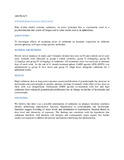Immunohistochemical localization of anterior pituitary cell types of vervet monkey (Chlorocebus aethiops) following sub-chronic cathinone exposure.

View/
Date
2015Author
Nyongesa, A
Oduma, J
al'Absi, M
Chirwa, S
Language
enMetadata
Show full item recordAbstract
ETHNOPHARMACOLOGICAL RELEVANCE:
Khat (Catha edulis) contains cathinone, an active principal that is customarily used as a psychostimulant that wards off fatigue and to some extent used as an aphrodisiac.
AIM OF STUDY:
To investigate effects of escalating doses of cathinone on hormone expression by different anterior pituitary cell types using specific antibodies.
MATERIAL AND METHODS:
Eleven vervet monkeys (6 males and 5 females) divided into tests (n=9) and controls (n=2) were used. Animals were allocated as group I (saline controls), group II (0.8mg/kg), group III (3.2mg/kg) and group IV (6.4mg/kg) of cathinone. All treatments were via oral route at alternate days of each week. At the end of 4- month treatment phase, GnRH agonist (ZOLADEX) was administered to group II (low dose) and group IV (high dose) alongside cathinone for 2 additional weeks.
RESULTS:
High cathinone dose at long-term exposure caused proliferation of gonadotrophs but decrease in lactotrophs and corticotrophs in anterior pituitary sections of animals while effect of low dose on these cells was insignificant. Subsequent GnRH agonist co-treatment with low and high cathinone doses enhanced gonadotroph proliferation but no change on decline of lactotrophs and corticotrophs.
CONCLUSION:
We believe that there was a possible potentiation of cathinone on pituitary hormone synthesis thereby influencing reproductive function. Suppression of corticotrophic and lactotrophic functions suggest lowering of stress levels and modulation of reproductive function based on dose level and chronicity of exposure. The findings are consistent with the hypothesis that cathinone interferes with pituitary cell integrity and consequently target organs, but further studies are required to address the precise mechanism underlying this phenomenon.
Citation
J Ethnopharmacol. 2015 Aug 12:JEPD1501109Publisher
University of Nairobi
Collections
- Faculty of Health Sciences (FHS) [10415]
